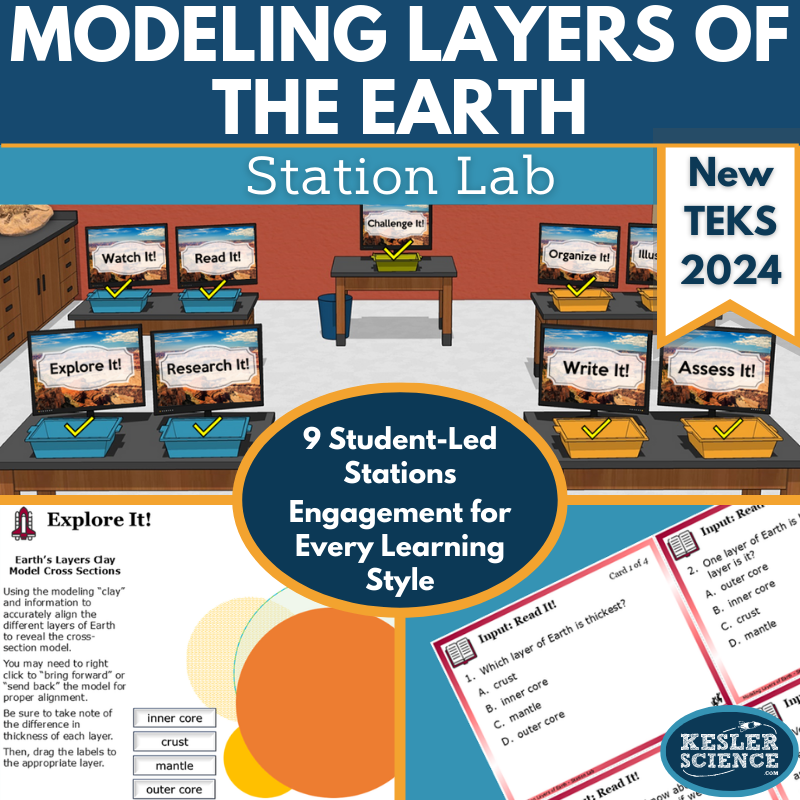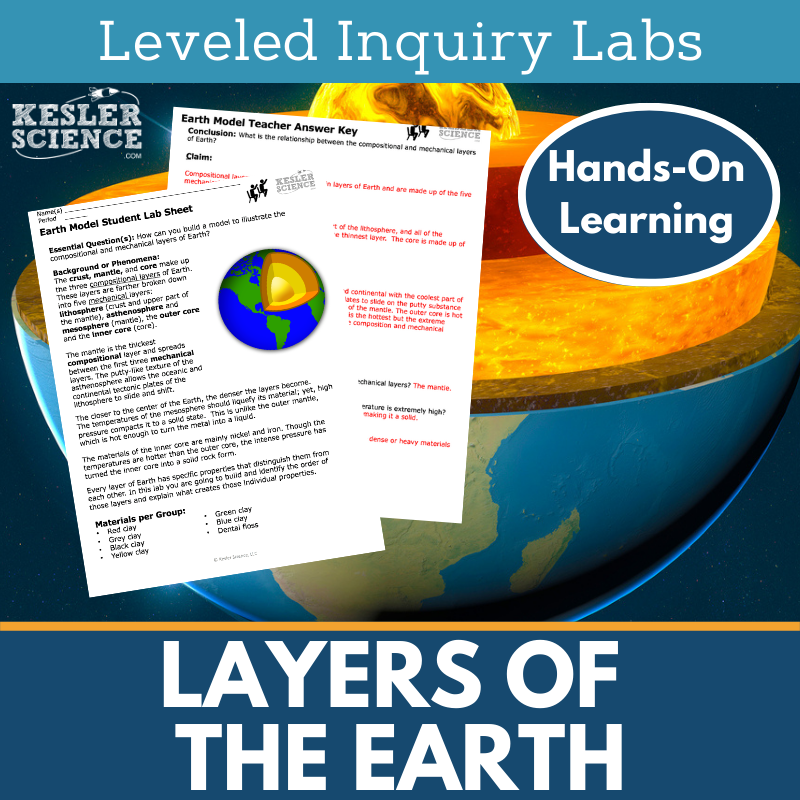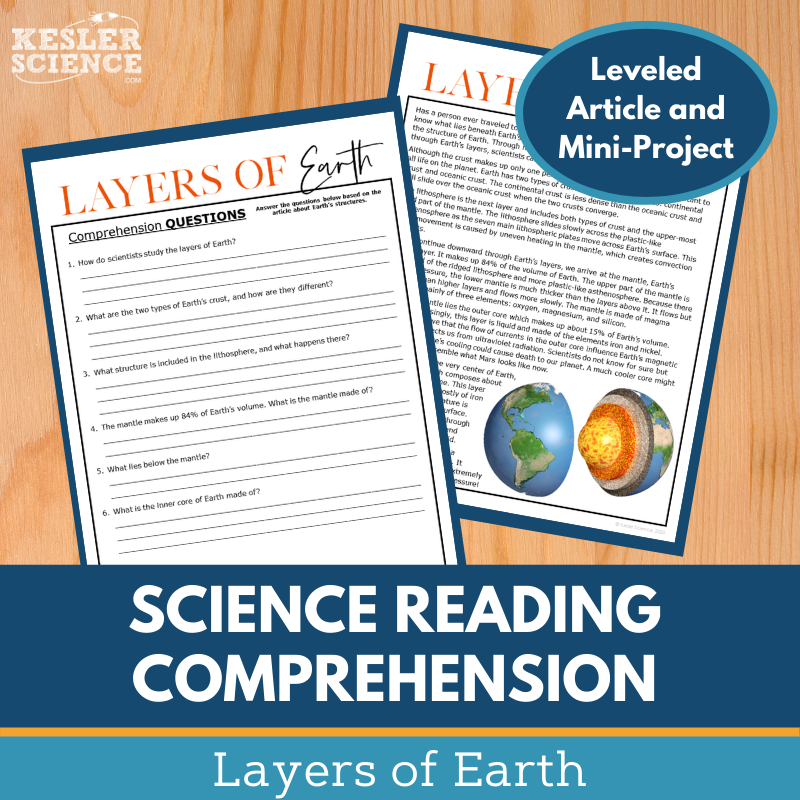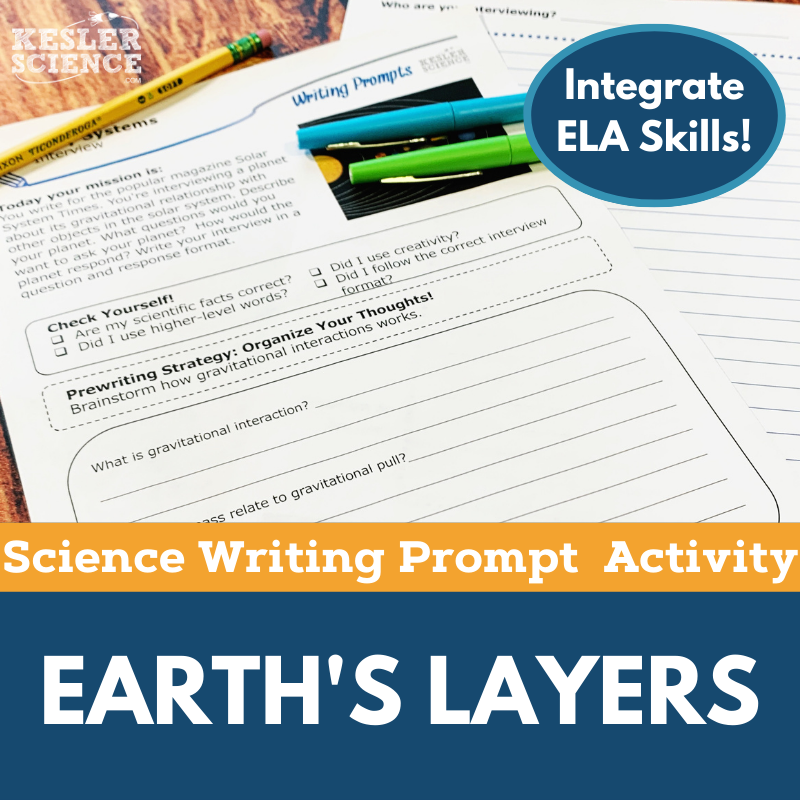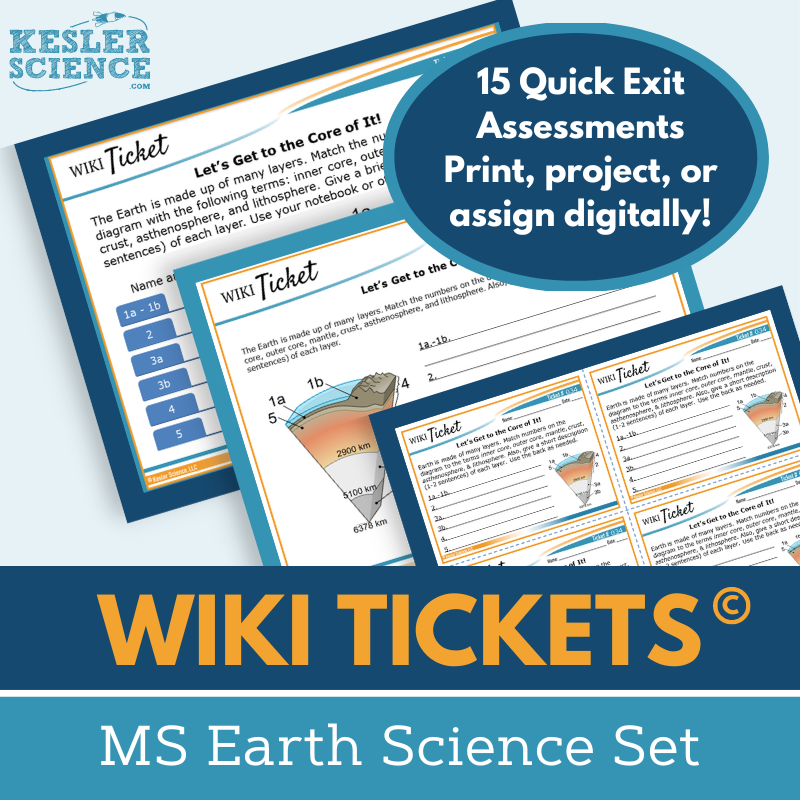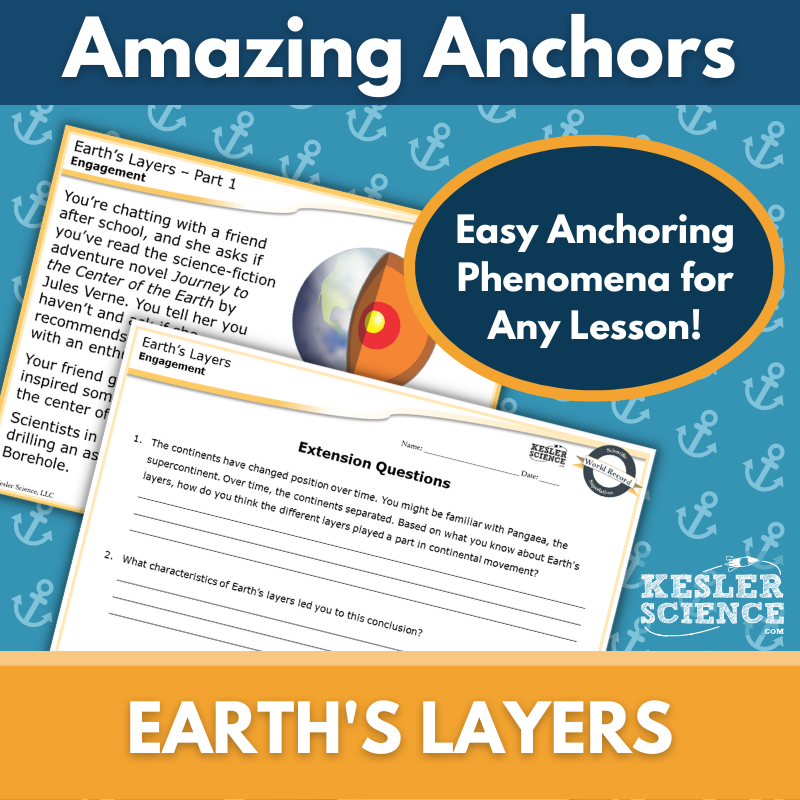Modeling Layers of the Earth Activities for Middle School Science
Students will explore Earth's inner core, outer core, mantle, and crust with this engaging 5E lesson. The resources below will give students a comprehensive understanding of Earth's layers. All of the following materials are also included in the Kesler Science Membership.
The Kesler Science Modeling Layers of the Earth 5E Lesson provides a comprehensive, student-led exploration of Earth’s inner core, outer core, mantle, and crust. This fully editable, low-prep unit includes presentations, worksheets, choice projects, and assessments designed for middle school learners. It incorporates multimodal learning, differentiated materials, and Spanish translations, ensuring accessibility for all students.
The lesson follows the 5E Model. Engagement activities include word wall cards and discussion prompts. In Exploration, a student-led station lab introduces Earth’s layers through hands-on experiments, readings, research, videos, and interactive tasks such as organizing, writing, illustrating, and assessing concepts. Explanation features editable PowerPoints, interactive notebooks, and note-taking templates. Elaboration extends learning with student-choice projects, while Evaluation includes STAAR 2.0-aligned assessments, review questions, and worksheets for test prep or homework.
With flexible digital and print formats, this lesson adapts seamlessly to in-class or virtual learning, ensuring students gain a thorough understanding of Earth’s internal structure.
The Kesler Science Modeling Layers of the Earth 5E Lesson provides a comprehensive, student-led exploration of Earth’s inner core, outer core, mantle, and crust. This fully editable, low-prep unit includes presentations, worksheets, choice projects, and assessments designed for middle school learners. It incorporates multimodal learning, differentiated materials, and Spanish translations, ensuring accessibility for all students.
The lesson follows the 5E Model. Engagement activities include word wall cards and discussion prompts. In Exploration, a student-led station lab introduces Earth’s layers through hands-on experiments, readings, research, videos, and interactive tasks such as organizing, writing, illustrating, and assessing concepts. Explanation features editable PowerPoints, interactive notebooks, and note-taking templates. Elaboration extends learning with student-choice projects, while Evaluation includes STAAR 2.0-aligned assessments, review questions, and worksheets for test prep or homework.
With flexible digital and print formats, this lesson adapts seamlessly to in-class or virtual learning, ensuring students gain a thorough understanding of Earth’s internal structure.
Engage your students with this student-led station lab aligned to the 2021 TEKS 6.10B standard. Designed for in-class or virtual learning, this lesson guides students as they model and describe Earth’s layers, including the inner core, outer core, mantle, and crust, through nine interactive stations featuring videos, readings, research, and hands-on tasks.
Students demonstrate their learning by organizing information, illustrating models, writing responses, and completing assessments. A bonus challenge station offers extension activities, and English and Spanish reading passages support differentiated learning. This low-prep, high-engagement resource promotes active learning and critical thinking.
Engage your students with this student-led station lab aligned to the 2021 TEKS 6.10B standard. Designed for in-class or virtual learning, this lesson guides students as they model and describe Earth’s layers, including the inner core, outer core, mantle, and crust, through nine interactive stations featuring videos, readings, research, and hands-on tasks.
Students demonstrate their learning by organizing information, illustrating models, writing responses, and completing assessments. A bonus challenge station offers extension activities, and English and Spanish reading passages support differentiated learning. This low-prep, high-engagement resource promotes active learning and critical thinking.
The Modeling Layers of the Earth Student Choice Projects align with the 2021 TEKS standard 6.10B, providing middle school students with various project options to showcase their understanding. A project page outlines six student-led choices plus a “design your own” project, all supported by an editable rubric for teacher, peer, or self-assessment.
These flexible, multimodal projects allow students to engage creatively while giving teachers the ability to adjust the rubric to fit grading needs. Two versions of the project page offer differentiation, with modified options for students needing remediation and opportunities for advanced learners to complete multiple projects using the same rubric.
The projects require standard classroom supplies such as paper, markers, and scissors, though many can be completed digitally.
The Modeling Layers of the Earth Student Choice Projects align with the 2021 TEKS standard 6.10B, providing middle school students with various project options to showcase their understanding. A project page outlines six student-led choices plus a “design your own” project, all supported by an editable rubric for teacher, peer, or self-assessment.
These flexible, multimodal projects allow students to engage creatively while giving teachers the ability to adjust the rubric to fit grading needs. Two versions of the project page offer differentiation, with modified options for students needing remediation and opportunities for advanced learners to complete multiple projects using the same rubric.
The projects require standard classroom supplies such as paper, markers, and scissors, though many can be completed digitally.
The Earth’s Layers Inquiry Lab aligns with TEKS standards, guiding students in constructing a model of Earth's compositional layers and identifying where the mechanical layers begin and end. Through this activity, students explore the continental crust, lithosphere, asthenosphere, mesosphere, mantle, inner core, and outer core.
This resource includes three differentiated labs to support diverse learning needs. The dependent student lab provides guided inquiry with procedural instructions, the modified student lab offers a structured approach with sentence stems or multiple-choice questions, and the independent student lab encourages student-led exploration with minimal guidance.
Teacher resource pages outline preparation, standards, objectives, materials, and directions. Answer keys and CER reflection questions help students formulate claims, evidence, and reasoning. All pages are editable for customization.
Students use clay in various colors to represent Earth's layers, along with dental floss for sectioning. This hands-on lab engages students in an interactive learning experience.
The Earth’s Layers Inquiry Lab aligns with TEKS standards, guiding students in constructing a model of Earth's compositional layers and identifying where the mechanical layers begin and end. Through this activity, students explore the continental crust, lithosphere, asthenosphere, mesosphere, mantle, inner core, and outer core.
This resource includes three differentiated labs to support diverse learning needs. The dependent student lab provides guided inquiry with procedural instructions, the modified student lab offers a structured approach with sentence stems or multiple-choice questions, and the independent student lab encourages student-led exploration with minimal guidance.
Teacher resource pages outline preparation, standards, objectives, materials, and directions. Answer keys and CER reflection questions help students formulate claims, evidence, and reasoning. All pages are editable for customization.
Students use clay in various colors to represent Earth's layers, along with dental floss for sectioning. This hands-on lab engages students in an interactive learning experience.
This Earth’s Layers Science Reading Comprehension Lesson helps students explore the compositional and mechanical properties of Earth's layers through a nonfiction article, comprehension questions, and a video. Designed for middle school students (grades 6-8, with higher-level 5th graders), the leveled passage supports science literacy and reading comprehension.
The resource includes two leveled articles (Lexile 1100-1300), five to seven comprehension questions, and a hands-on, interactive mini-project. A Cornell notes template is also provided. The passage features engaging, colorful graphics that can be printed in grayscale.
Suitable for virtual and in-person learning, this resource integrates seamlessly with Google Classroom, MS Teams, Schoology, and Canvas. Students can complete assignments directly in the provided PPT file or Google Slides. Perfect for sub plans, ISS, extra credit, or whole-class instruction, this lesson fosters critical thinking, textual analysis, and classroom discussions on Earth’s layers.
This Earth’s Layers Science Reading Comprehension Lesson helps students explore the compositional and mechanical properties of Earth's layers through a nonfiction article, comprehension questions, and a video. Designed for middle school students (grades 6-8, with higher-level 5th graders), the leveled passage supports science literacy and reading comprehension.
The resource includes two leveled articles (Lexile 1100-1300), five to seven comprehension questions, and a hands-on, interactive mini-project. A Cornell notes template is also provided. The passage features engaging, colorful graphics that can be printed in grayscale.
Suitable for virtual and in-person learning, this resource integrates seamlessly with Google Classroom, MS Teams, Schoology, and Canvas. Students can complete assignments directly in the provided PPT file or Google Slides. Perfect for sub plans, ISS, extra credit, or whole-class instruction, this lesson fosters critical thinking, textual analysis, and classroom discussions on Earth’s layers.
The Earth’s Layers Science Writing Prompt Activity engages middle school students in a creative narrative exercise to test their understanding of Earth’s structural layers. Aligned with TEKS, this activity encourages students to explore science reasoning and writing while supporting both in-person and virtual learning.
This resource includes teacher directions with an answer guide, project ideas, and rubrics. It offers projection and print-friendly versions, including full-sized and half-sheet handouts with prompts, self-checks, and pre-writing strategies. A digital interactive PowerPoint version, compatible with Google Slides, allows for remote or in-class completion.
Ideal for cross-curricular activities, pre-test assessments, student choice projects, early finisher tasks, extra credit, make-up work, TELPAS samples, or differentiation, this writing prompt fosters engagement and creativity. It can also be displayed on bulletin boards or compiled into student anthologies.
The Earth’s Layers Science Writing Prompt Activity engages middle school students in a creative narrative exercise to test their understanding of Earth’s structural layers. Aligned with TEKS, this activity encourages students to explore science reasoning and writing while supporting both in-person and virtual learning.
This resource includes teacher directions with an answer guide, project ideas, and rubrics. It offers projection and print-friendly versions, including full-sized and half-sheet handouts with prompts, self-checks, and pre-writing strategies. A digital interactive PowerPoint version, compatible with Google Slides, allows for remote or in-class completion.
Ideal for cross-curricular activities, pre-test assessments, student choice projects, early finisher tasks, extra credit, make-up work, TELPAS samples, or differentiation, this writing prompt fosters engagement and creativity. It can also be displayed on bulletin boards or compiled into student anthologies.
The WIKI Tickets© Earth Science Set provides 15 formative assessments designed for 6th-8th grade science, offering flexible and engaging ways to check student understanding. Each topic includes five formats: a full-screen projection version, three print handout sizes, and a digital interactive version compatible with PowerPoint and Google Slides.
Aligned with NGSS and TEKS standards, these assessments cover key Earth science topics such as ecoregions in Texas, human impact on the environment and natural resources, land and erosion features, Earth’s layers, tectonic plates, plate movement, minerals, the rock cycle, fossil fuels, watersheds, and groundwater. Some topics have multiple tickets, ensuring comprehensive coverage of the standards. A table of contents file is included for easy alignment reference.
WIKI Tickets© can be used in both in-person and virtual learning environments as exit tickets, bellringers, or quick assessments. Students can write responses on paper when projected, complete printed handouts, or use digital copies in a 1:1 or remote setting. These colorful and engaging assessments provide a versatile tool to gauge student progress effectively.
The WIKI Tickets© Earth Science Set provides 15 formative assessments designed for 6th-8th grade science, offering flexible and engaging ways to check student understanding. Each topic includes five formats: a full-screen projection version, three print handout sizes, and a digital interactive version compatible with PowerPoint and Google Slides.
Aligned with NGSS and TEKS standards, these assessments cover key Earth science topics such as ecoregions in Texas, human impact on the environment and natural resources, land and erosion features, Earth’s layers, tectonic plates, plate movement, minerals, the rock cycle, fossil fuels, watersheds, and groundwater. Some topics have multiple tickets, ensuring comprehensive coverage of the standards. A table of contents file is included for easy alignment reference.
WIKI Tickets© can be used in both in-person and virtual learning environments as exit tickets, bellringers, or quick assessments. Students can write responses on paper when projected, complete printed handouts, or use digital copies in a 1:1 or remote setting. These colorful and engaging assessments provide a versatile tool to gauge student progress effectively.
Lesson Extensions provide engaging, student-choice activities designed to challenge early finishers and deepen their understanding of Earth science standards. These activities help fill downtime, reinforce critical thinking, and keep students engaged with rigorous yet enjoyable learning opportunities. Aligned to NGSS and TEKS, they support independent learning and enrichment.
Each extension includes four interactive components: Puzzler for problem-solving, Maker Space for hands-on STEAM activities, Tech Connection for digital demonstrations, and Word Master for creative writing. With teacher directions, answer keys, and both print and projection versions, these extensions are perfect for lesson wrap-ups, enrichment, or independent challenges.
Topics covered include circulation and climate, climate change, Earth's changing surface, tectonic plates, the fossil record, and more. These extensions ensure students remain engaged while exploring key Earth science concepts at a deeper level.
Lesson Extensions provide engaging, student-choice activities designed to challenge early finishers and deepen their understanding of Earth science standards. These activities help fill downtime, reinforce critical thinking, and keep students engaged with rigorous yet enjoyable learning opportunities. Aligned to NGSS and TEKS, they support independent learning and enrichment.
Each extension includes four interactive components: Puzzler for problem-solving, Maker Space for hands-on STEAM activities, Tech Connection for digital demonstrations, and Word Master for creative writing. With teacher directions, answer keys, and both print and projection versions, these extensions are perfect for lesson wrap-ups, enrichment, or independent challenges.
Topics covered include circulation and climate, climate change, Earth's changing surface, tectonic plates, the fossil record, and more. These extensions ensure students remain engaged while exploring key Earth science concepts at a deeper level.
This Amazing Anchors Phenomenon Lesson introduces the Earth’s layers through the real-world example of the Kola Superdeep Borehole. It includes an introductory reading with comprehension and extension questions to prepare students for further learning, followed by an explanatory reading that breaks down the science behind the Earth’s layers in an understandable way.
Aligned with TEKS, this no-prep resource includes teacher directions, answer keys, projection slides, and both print and digital formats for Google Classroom and other LMS platforms. A differentiated version provides sentence starters to support student comprehension. Designed to bookend a lesson, these engaging readings serve as valuable supplements to reinforce learning in any classroom setting.
This Amazing Anchors Phenomenon Lesson introduces the Earth’s layers through the real-world example of the Kola Superdeep Borehole. It includes an introductory reading with comprehension and extension questions to prepare students for further learning, followed by an explanatory reading that breaks down the science behind the Earth’s layers in an understandable way.
Aligned with TEKS, this no-prep resource includes teacher directions, answer keys, projection slides, and both print and digital formats for Google Classroom and other LMS platforms. A differentiated version provides sentence starters to support student comprehension. Designed to bookend a lesson, these engaging readings serve as valuable supplements to reinforce learning in any classroom setting.
Year-Round Resources
These year-round activities will increase your students' understanding of many middle school science topics. All of these activities are also included in the Kesler Science Membership.
Visual Data & Graphing
You're not alone if your students struggle with understanding graphs, charts, and tables. It's a skill that takes an enormous amount of practice. This resource will help students build a strong foundation in analyzing data and creating their own data visualizations.
Bell Ringers and Warm-Ups
These middle school science bell ringers are an excellent way to engage your students as soon as they walk into your classroom. This comprehensive FULL YEAR resource includes everything you need to start off each science class with an interesting warm-up activity.
Review Board Games
Each game board has been carefully designed to keep students engaged. There are 10 different action spaces on each board and dozens of question cards. All of the actions are related to science concepts and keep the students motivated throughout the game.
Each game is ready to play. Simply print out the board and the cards and let the students enjoy reviewing nine different units.
Essential Questions and Standards
Below are the essential questions and standards associated with the lessons and activities included in the atoms unit. This topic is only one of more than 100 middle school science topics included in the Kesler Science Membership.
-
How can we model the layers of Earth, including the inner core, outer core, mantle, and crust?
-
How do we describe the layers of Earth, including the inner core, outer core, mantle, and crust?
-
TEKS Science - 6.10B Modeling Layers of the Earth
Kesler Science Membership
Imagine never having to search for another middle school science lesson again. The membership gives you access to ALL of the Kesler Science products in one place (Yes, including everything above).
Say goodbye to long hours of lesson prep.



